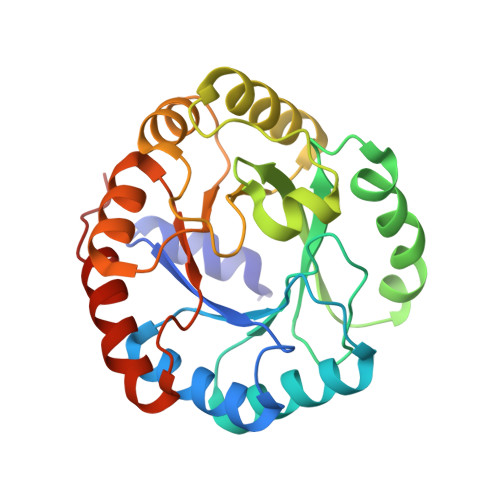Structural studies of geranylgeranylglyceryl phosphate synthase, a prenyltransferase found in thermophilic Euryarchaeota.
Blank, P.N., Barnett, A.A., Ronnebaum, T.A., Alderfer, K.E., Gillott, B.N., Christianson, D.W., Himmelberger, J.A.(2020) Acta Crystallogr D Struct Biol 76: 542-557
- PubMed: 32496216
- DOI: https://doi.org/10.1107/S2059798320004878
- Primary Citation of Related Structures:
6NKE - PubMed Abstract:
Archaea are uniquely adapted to thrive in harsh environments, and one of these adaptations involves the archaeal membrane lipids, which are characterized by their isoprenoid alkyl chains connected via ether linkages to glycerol 1-phosphate. The membrane lipids of the thermophilic and acidophilic euryarchaeota Thermoplasma volcanium are exclusively glycerol dibiphytanyl glycerol tetraethers. The first committed step in the biosynthetic pathway of these archaeal lipids is the formation of the ether linkage between glycerol 1-phosphate and geranylgeranyl diphosphate, and is catalyzed by the enzyme geranylgeranylglyceryl phosphate synthase (GGGPS). The 1.72 Å resolution crystal structure of GGGPS from T. volcanium (TvGGGPS) in complex with glycerol and sulfate is reported here. The crystal structure reveals TvGGGPS to be a dimer, which is consistent with the absence of the aromatic anchor residue in helix α5a that is required for hexamerization in other GGGPS homologs; the hexameric quaternary structure in GGGPS is thought to provide thermostability. A phylogenetic analysis of the Euryarchaeota and a parallel ancestral state reconstruction investigated the relationship between optimal growth temperature and the ancestral sequences. The presence of an aromatic anchor residue is not explained by temperature as an ecological parameter. An examination of the active site of the TvGGGPS dimer revealed that it may be able to accommodate longer isoprenoid substrates, supporting an alternative pathway of isoprenoid membrane-lipid synthesis.
- Department of Chemistry, University of Pennsylvania, 231 South 34th Street, Philadelphia, PA 19104, USA.
Organizational Affiliation:



















